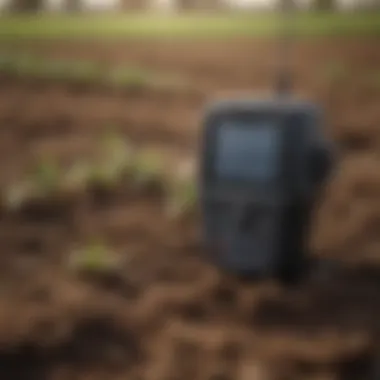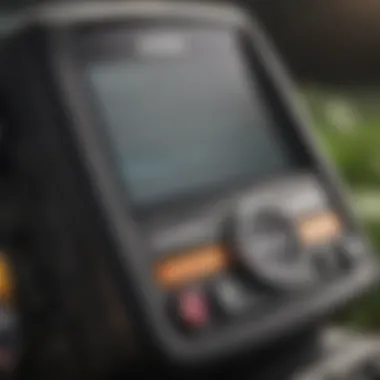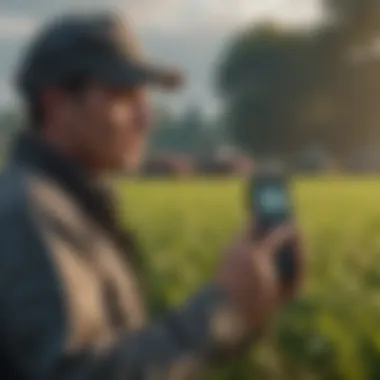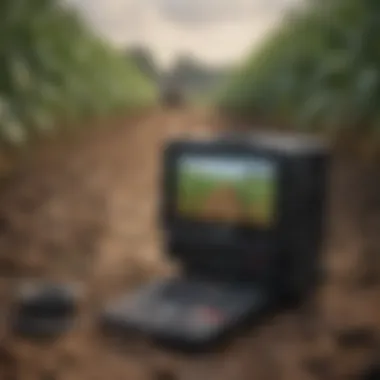Understanding the Motorola DTR: A Comprehensive Overview


Intro
The Motorola DTR stands as a significant innovation in the realm of digital communication. In an age where efficiency and prompt communication are paramount, especially within agriculture, this device focuses on delivering reliable solutions suited to diverse environments. Utilized heavily in sectors such as agriculture and horticulture, the Motorola DTR has transformed how professionals interact and share critical information. This article will explore its design, key features, and practical applications, offering insight into its role in enhancing operational efficiency among farmers and agricultural specialists.
Topic Overview
Definition and Importance
The Motorola DTR is a digital two-way radio system that offers seamless communication without the need for a cellular network. It is designed to be user-friendly, making it a practical choice for farmers who may need to communicate across large distances or in areas with limited connectivity. The importance of the Motorola DTR lies not only in its communication capabilities but also in how it integrates into the broader landscape of modern agricultural practices. By optimizing communication, it enables faster decision-making and improves overall efficiency.
Brief History and Evolution
The journey of the Motorola DTR began with the evolution of digital radio technology. Initially, communication in agriculture relied on basic forms of two-way radios. As demands for clearer, more efficient communication grew, Motorola adapted its technology to meet these needs. The DTR series exemplifies a shift towards digital solutions, offering features such as enhanced audio quality, longer range, and increased durability. Over the years, these devices have kept pace with technological advancements, proving essential in modern agricultural settings.
Key Techniques and Innovations
Sustainable Farming Practices
The Motorola DTR has a pivotal role in promoting sustainable farming practices. With the capability for instant communication, farmers can coordinate activities that minimize waste and improve resource management. Whether it is alerting teams to changes in weather conditions or managing irrigation systems, the swift communication enabled by this device helps farmers implement more sustainable methods in their operations.
Advanced Agronomic Technologies
As precision agriculture becomes more prevalent, tools like the Motorola DTR integrate with various agronomic technologies. This includes systems for monitoring crop health, soil conditions, and weather patterns. The DTR allows for instant feedback from field operatives to decision-makers. This collaboration significantly enhances the way farms operate, allowing for timely interventions that drive productivity up.
Practical Applications
Step-by-Step Guides
- Set Up: Begin by charging the Motorola DTR, ensuring a full battery before first use. Familiarize yourself with its controls, including volume and channel options.
- Choose Channels: Select the appropriate communication channels based on the team's needs. The DTR supports multiple channels, providing flexibility for different groups.
- Conduct Training: Train team members on effective communication practices using the DTR. This can include speaking clearly and defining guidelines for urgent messaging.
- Monitor Communications: Regularly check the clarity of communications between team members, ensuring optimal performance of the device.
Case Studies or Real-World Examples
A notable case is how a local farming cooperative adopted the Motorola DTR to streamline their operations. By using the device, they achieved better coordination during planting and harvesting seasons. They reported a significant reduction in delays caused by miscommunication, which allowed them to maximize crop yields effectively.
"Communication is the backbone of successful farming. The Motorola DTR has transformed how we interact on the field." - A satisfied user.
Prolusion to Motorola DTR
In an era where effective communication is vital for productivity and safety, the Motorola DTR device stands out as a significant innovation. This article will explore its relevance in various sectors, especially in agriculture. Farmers and agricultural professionals often face unique challenges, such as large communication gaps across expansive fields. The Motorola DTR serves as a solution, enhancing connectivity in these environments, which is essential for efficient operations.
The Motorola DTR is designed specifically for digital two-way communication, offering features that are tailored to the needs of users in dynamic settings. Understanding this device not only highlights its functionality but also uncovers its impact on modern farming practices. Professionals in agriculture can leverage the unique capabilities of the DTR for seamless communication, enhancing collaboration and decision-making.
What is the Motorola DTR?
The Motorola DTR is a digital two-way radio that uses advanced technology to provide clear and reliable communication. Unlike traditional walkie-talkies, the DTR uses a license-free frequency range, allowing users to communicate across a distance without the need for complex radio licenses. Operating on the 900 MHz band, this radio provides better penetration and range, especially in rural areas where obstructions can hinder signal clarity.
With the DTR, users can expect features such as:
- Digital voice clarity that minimizes background noise.
- Privacy settings, allowing secure conversations without eavesdropping.
- Multiple channels that enable users to separate discussions or teams.
This device caters to a variety of fields but is particularly pivotal in agriculture, where timely communication can mean the difference between successful operations and costly delays.
The Evolution of Communication Devices in Agriculture


Communication devices have dramatically evolved over the years. Traditionally, farmers relied on verbal communication and physical presence for coordination. As technology advanced, simple landline phones and radios began to replace these practices, but they came with limitations, such as poor range and inability to operate in remote settings.
The introduction of digital radios, like the Motorola DTR, revolutionized how agricultural professionals communicate. The transition from analog to digital has significantly improved signal strength, audio quality, and reliability. Now farmers can connect instantly, regardless of their location on the farm.
Key changes in agricultural communication include:
- Adoption of mobile phones, which provided mobility but lacked the ruggedness required in agricultural environments.
- Use of satellite phones for remote locations, though these can be expensive and less reliable.
In this context, the Motorola DTR emerges as a perfect blend of mobility, durability, and functionality, designed specifically to address the unique needs of farmers and agricultural workers. Its focus on clear communication ensures that operations run smoothly and efficiently, making it a game-changer in the industry.
Key Features of the Motorola DTR
The Motorola DTR is a sophisticated tool that plays a crucial role in enhancing communication, especially in the agricultural sector. The significance of its key features lies in their ability to streamline operations, enhance safety, and improve overall efficiency. Below, I highlight the specific elements that contribute to its value, offering insights into how these features benefit users within the context of agriculture.
Digital Two-Way Communication
Digital two-way communication is at the heart of what the Motorola DTR offers. Unlike traditional analog radios, the DTR utilizes a digital platform that delivers a clearer signal with minimal interference. This feature ensures that conversations remain uninterrupted, which is vital during critical operations such as planting or harvesting.
Furthermore, the DTR allows multiple users to communicate simultaneously on different channels. This capability facilitates coordinated efforts among farm workers, enabling them to respond more effectively to changing situations on the ground. Overall, the reliability of communication can lead to better decision-making and greater productivity in the field.
Robust Build Quality
The build quality of the Motorola DTR is one of its strongest selling points. Designed to withstand the rigors of outdoor environments, the DTR is both dust and water-resistant. Farmers often work in challenging conditions, and a device that can endure rough handling and exposure to elements is essential.
This durability not only protects the device but also reduces the frequency of replacements or repairs, translating into long-term cost savings for agricultural operations. Coupled with a lightweight design, the Motorola DTR is practical and convenient for daily use, affirming its place as a reliable communication tool in the field.
Voice Clarity and Audio Quality
Another crucial aspect of the Motorola DTR is its superior voice clarity and audio quality. Clear audio quality is critical for effective communication, especially in noisy environments typical on farms. The DTR incorporates advanced technology to filter out background noise, ensuring voices stand out during conversations.
Users appreciate this clarity because it helps prevent misunderstandings that could lead to costly mistakes. When team members can communicate effectively, it enhances collaboration and aligns their efforts, ultimately leading to successful outcomes in their tasks.
Battery Life and Efficiency
Battery life is a fundamental consideration for any handheld communication device, and the Motorola DTR excels in this regard. It boasts an impressive battery life that allows for extended use without frequent recharging. For farmers, who may operate for hours, this capability is invaluable.
In addition to long battery life, the Motorola DTR is designed for energy-efficient operation. The smart power-saving features help extend usage time, meaning users can stay connected throughout their workday. This efficiency ensures that channels remain open for necessary communication without the worry of losing power in critical moments.
In summary, the Motorola DTR's key features provide significant advantages that improve communication efficiency, reliability, and overall performance in agriculture and beyond. Understanding these features is vital for maximizing the device’s potential in enhancing operational productivity.
Applications in Agriculture
The significance of the Motorola DTR in agricultural settings cannot be overstated. Effective communication is essential in managing farms efficiently. The DTR device enhances operational capability on farms by facilitating clear and immediate exchanges of information. This is increasingly important as the agricultural sector becomes more complex with varying operational needs and technologies.
Enhancing Communication in Farm Management
Utilizing Motorola DTR within farm management streamlines various processes. Communication among team members improves significantly. With the device's digital clarity, short communication bursts replace lengthy discussions. This efficiency increases productivity and helps to address issues rapidly. Whether coordinating planting schedules or discussing equipment maintenance, real-time communication is pivotal.
Additionally, the DTR offers a centralized communication platform for team leaders and workers. With features like group calling and private channels, the device supports different communication needs, fostering better teamwork. Farmers no longer miss critical updates, leading to smoother operations overall.
Coordination During Harvesting Seasons
Harvesting periods are crucial in agriculture, necessitating precise coordination among many workers. The Motorola DTR plays a vital role in ensuring that every aspect of the harvest runs smoothly. By providing instant connectivity, it allows supervisors to manage crews effectively, optimizing the allocation of labor and resources.
During these busy times, the ability to quickly relay information about crop readiness, equipment status, or unexpected challenges is invaluable. Traditional methods such as walkie-talkies or shouting across fields can lead to miscommunication and delays. DTR eliminates these issues with its reliable transmission and clear audio quality. This tool helps coordinate efforts, cutting down unnecessary wasted time.


Safety Communication on Agricultural Sites
Safety is paramount in any workplace, and agriculture is no exception. The Motorola DTR enhances safety communication on farms. With features designed for quick alerting and announcements, the DTR helps in managing safety protocols effectively.
In situations where accidents can happen, immediate communication can be crucial. Having the DTR means that workers can notify each other promptly in emergencies. For instance, notifying the team about hazardous machinery is much quicker when using a DTR compared to other devices. Furthermore, these devices provide peace of mind to workers, knowing they can communicate effortlessly in case of an incident.
"Clear communication can drastically improve safety standards and operational efficiency on farms."
Incorporating the Motorola DTR within agricultural communication strategies not only boosts productivity but also enhances safety measures across farming operations.
Comparative Analysis with Other Communication Devices
Comparative analysis plays a crucial role in understanding the distinct merits of the Motorola DTR. For agricultural professionals, selecting the right communication device can significantly affect operational efficiency. Understanding contrasts between the DTR and other devices, such as analog radios and mobile phones, enables users to make informed decisions based on their specific needs and environments.
Motorola DTR vs. Analog Radios
The Motorola DTR operates using digital technology, which provides notable advantages over analog radios. Firstly, the digital communication allows for clearer audio and more stable connections. This is essential in environments like farms where background noise can impede communication. Analog radios often suffer from static and interference, impacting the effectiveness of message delivery.
Further, the Motorola DTR supports encrypted communications. This feature is particularly beneficial for organizations concerned about information security. Meanwhile, analog radios offer more limited security measures, making them less suitable for sensitive communications.
In terms of range, the Motorola DTR generally has superior performance. Users can expect a clearer signal over longer distances in open agricultural zones, while analog radios may fail under similar conditions. That said, analog radios do have their strengths, especially in simple setups and cost, as they are typically cheaper and easier to use without requiring digital expertise.
Motorola DTR vs. Mobile Phones
When comparing the Motorola DTR with mobile phones, the context of use becomes increasingly important. Mobile phones provide versatility, allowing not only voice communication but also text, video, and data exchange. However, they rely heavily on cellular networks, which may be unreliable in rural or remote agricultural settings.
Conversely, the Motorola DTR operates on a private network, ensuring more consistent communication without dependence on external service providers. This aspect makes it particularly valuable for farm operations where connectivity can be a challenge. In addition, the DTR offers extended battery life tailored for long work shifts in the field, contrasting with smartphones, which often require frequent charging.
While mobile phones have advanced features, the specialized nature of the Motorola DTR makes it a more focused choice for direct, clear communication in farming scenarios. Moreover, users looking for a device that minimizes distractions could prefer the straightforward functionality of the Motorola DTR.
"Choosing the right communication tool is vital for maintaining effective operations, especially in agriculture where timely updates can significantly affect outcomes."
Technological Integration
Technological integration is vital in understanding the impact of the Motorola DTR in modern farming. As communication becomes more essential in agriculture, the need for devices like the DTR grows stronger. These tools not only streamline everyday operations but also enhance overall farm productivity. The adaptation of technological systems fosters collaboration among various farm functions, from crop management to labor coordination.
Integrating the DTR with existing agricultural technologies can yield substantial benefits. Farmers can optimize resource use, improve real-time communication, and even monitor equipment performance remotely. Consequently, integrating communication devices can serve as a catalyst for smarter farming practices.
Integrating DTR with Modern Agricultural Tools
The integration of the Motorola DTR with modern agricultural tools enables seamless connectivity across all farm operations. For instance, when paired with GPS systems, the DTR can facilitate precise communication regarding field layouts, planting schedules, and pest control measures.
When using harvesters fitted with sensors, the DTR provides timely updates to operators about yields, equipment malfunctions, or maintenance needs. This integration minimizes downtime and maximizes efficiency. Tools that enable data transfer, such as weather monitoring devices, can also enhance decision-making processes. Here are a few specific advantages:
- Improved Coordination: Ensures teams are aligned in tasks such as irrigation, planting, and harvesting.
- Enhanced Data Sharing: Allows instant sharing of critical information which is necessary for informed decisions.
- Efficient Resource Management: Reduces waste by coordinating the use of labor and machinery efficiently.
Adopting IoT for Enhanced Functionality
The integration of the Internet of Things (IoT) with the Motorola DTR represents a significant leap forward in agricultural technology. By adopting IoT solutions, farmers gain access to a wealth of data from various sources. This can include soil moisture levels, crop health analytics, and environmental condition metrics that are vital for decision-making.
IoT devices can communicate with the DTR to provide real-time updates, improving overall responsiveness in farm operations. Consider this:
Once a sensor on a tractor detects that soil moisture is low, it can send an alert through the DTR to the relevant team members. This enables immediate action to irrigate the affected areas. By leveraging IoT capabilities, the following are enabled:


- Increased Automation: Automates farming tasks, allowing for more precise interventions.
- Predictive Analysis: Helps in forecasting potential issues before they become significant.
- Connectivity Across Devices: Bridges the gap between various operational tools on the farm.
"Implementing IoT with devices like the Motorola DTR is not just an upgrade; it's a transformation in how farming can be approached."
Integrating technologies not only enhances existing workflows but also sets the stage for future innovations within the agricultural sector. Recognizing these new possibilities can lead to better resource management and improved overall productivity.
User Experience and Feedback
In the landscape of modern agriculture, user experience plays a crucial role in the effectiveness of communication devices like the Motorola DTR. Understanding how users interact with these tools provides insights into their practical value. Positive user experiences can significantly enhance productivity and efficiency on farms. As such, reliability, ease of use, and satisfaction are vital components to consider when evaluating the Motorola DTR.
User Satisfaction and Reliability
User satisfaction directly correlates with how the Motorola DTR performs in real-world conditions. Farmers need devices that not only work but also withstand the rigors of agricultural life. Key factors include network coverage, durability, and the device's ability to maintain a clear connection over long distances. Users report satisfaction stemming from the DTR's robustness and consistent performance under challenging conditions.
- Durability: The Motorola DTR exhibits a solid build quality which is essential for work environments. The device can endure exposure to dust, moisture, and physical impacts.
- Dependability: Reliable communication ensures that teams can coordinate operations smoothly. Policymakers and farmers rely on the DTR to operate without interruption.
- User-Friendly Features: Intuitive design facilitates easy operation, which is critical during peak seasons like harvest time when quick communication is vital.
On various agricultural forums, users suggest that the DTR's ease in setup and functionality contributes to overall satisfaction, especially for those who may not be tech-savvy. Users appreciate quick access to critical information and the ability to communicate instantly with team members, illustrating the device’s practical application and importance in everyday tasks.
Real-world Case Studies
Examining real-world case studies helps illuminate the benefits of utilizing Motorola DTR devices in agriculture. These examples show how farmers implement the technology in diverse scenarios, leading to enhanced operational efficiency.
- Case Study on Large Scale Crop Management
A mid-sized farm specializing in corn production implemented the Motorola DTR for their coordination during planting and harvesting. Farmers noted a marked improvement in communication speeds. They could address issues promptly, boosting overall productivity by over 20% during critical times. - Emergency Communication
In a recent incident, a farm team used the Motorola DTR to manage emergency communication when machinery malfunctioned. The clear audio quality ensured swift coordination among team members, reducing downtime and saving valuable resources. - Community Farming Initiatives
A cooperative of smallholder farmers employed the DTR for effective collaboration. They shared updates on crop conditions and weather changes. The communication helped avert losses from unexpected weather events by enabling timely responses.
"Communication is key in agriculture; clear and effective tools like the Motorola DTR make a significant difference in addressing on-the-ground issues promptly."
These case studies demonstrate that the Motorola DTR stands out in facilitating vital connections during critical operational phases. The feedback from users reinforces the notion that communication technology is an indispensable asset in the agricultural sector.
Future Developments
As the landscape of communication technology continues to shift rapidly, understanding the prospective advancements in devices like the Motorola DTR is vital. New developments can enhance both user experience and operational efficiency within agriculture. Identifying these elements will allow professionals to stay ahead in leveraging effective communication tools.
Potential Advancements in Communication Technology
The future promises several potential advancements that could transform communication technology, specifically for devices like the Motorola DTR. Some of these advancements may include:
- Improved Connectivity Options: Enhanced wireless networks, including 5G, are poised to increase the reliability and range of communication devices. This would allow for seamless connections even in remote farming locations.
- Higher Data Capacities: As technologies evolve, the ability to transmit larger amounts of data quickly can be realized. This may facilitate the exchange of real-time farm data, giving farmers more resources to make informed decisions.
- Interoperability with Different Platforms: Future communication tools may focus on interconnectivity with various platforms and devices. This could allow the Motorola DTR to work in tandem with other digital tools, increasing its utility in farm management.
Investing in these advancements could lead to significant improvements in productivity and resource management within agricultural settings.
The Role of AI and Automation
Artificial intelligence and automation will play a pivotal role in the future of communication technology. These innovations are expected to integrate seamlessly with communication devices like the Motorola DTR, offering several benefits:
- Enhanced Decision-Making: AI can analyze vast amounts of data to provide insights. For farmers, this means better decisions can be made based on predictive analytics, improving overall productivity.
- Automated Communication Responses: With automation, communication can become more effective. Tools that respond in real-time to queries or alerts can help streamline farm operations.
- Data Security: As communication technology becomes increasingly integral to farm management, AI can also improve security measures. It can identify threats and provide mechanisms to safeguard sensitive information.
"The integration of AI with communication devices represents a fundamental shift in operational strategies within agriculture."
The infusion of AI and automation into communication devices like the Motorola DTR signifies not just an upgrade in technology but a transformation in how agricultural professionals operate, interact, and optimize their processes.
End
The conclusion of this article serves as a vital component, synthesizing the key themes discussed throughout our exploration of the Motorola DTR. It underscores the significance of this digital communication tool in enhancing operational efficiency within the agricultural sector. The Motorola DTR does not merely function as a communication device; it embodies an evolution in the way farmers and agricultural workers engage with each other and their environment.
Summarizing the Impact of Motorola DTR
The Motorola DTR represents a substantial shift in agricultural communication. Unlike traditional devices, it offers digital clarity and efficient connectivity, which are crucial in a field that relies heavily on timely information. With features like robust build quality, long battery life, and superior audio clarity, users can depend on this device even in challenging environments. Its impact can be seen through improved coordination during harvesting and better safety communication on agricultural sites. The seamless integration of the DTR with modern farming tools further enhances its utility. This device allows for more streamlined operations, decreasing downtime and improving overall productivity.
Final Thoughts on Effective Communication in Agriculture
Effective communication is foundational to success in agriculture. As operations grow in complexity, having reliable communication tools becomes essential. The Motorola DTR not only meets this demand but elevates it by providing a platform that ensures clarity and reliability. As farmers adopt advanced technologies, the role of devices like the DTR will only increase. It stands as a testament to the importance of evolving communication methods in order to keep pace with the changing landscape of the agricultural industry. Stakeholders should consider its potential impact as they plan for more connected and efficient farming practices.



